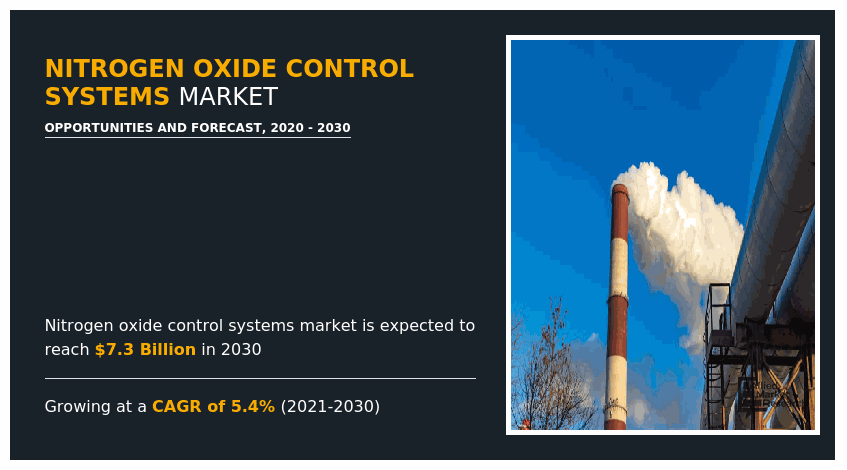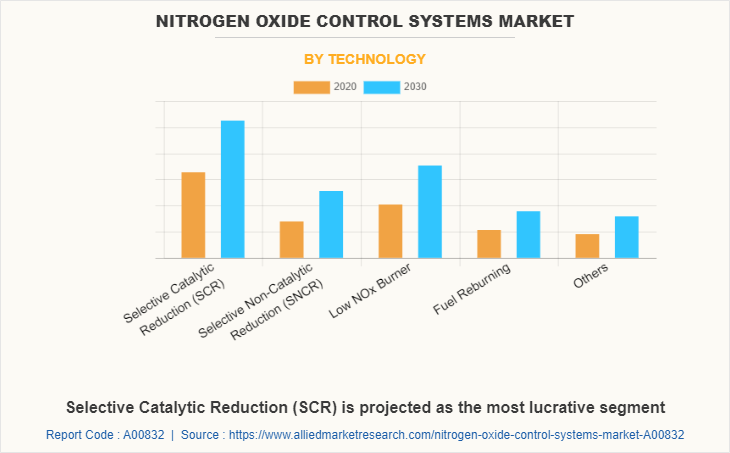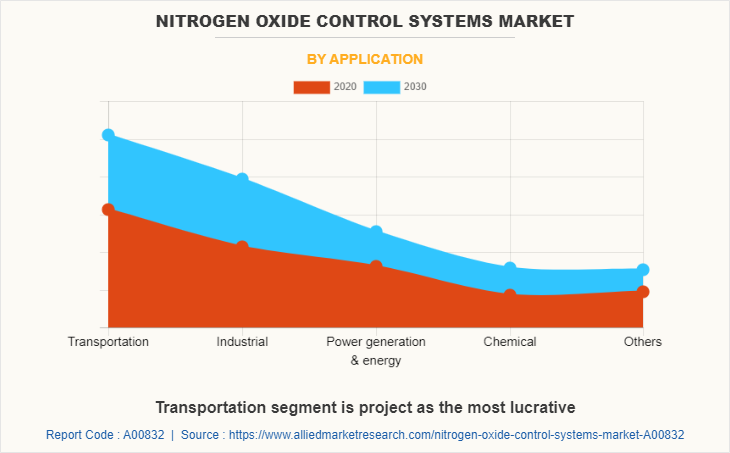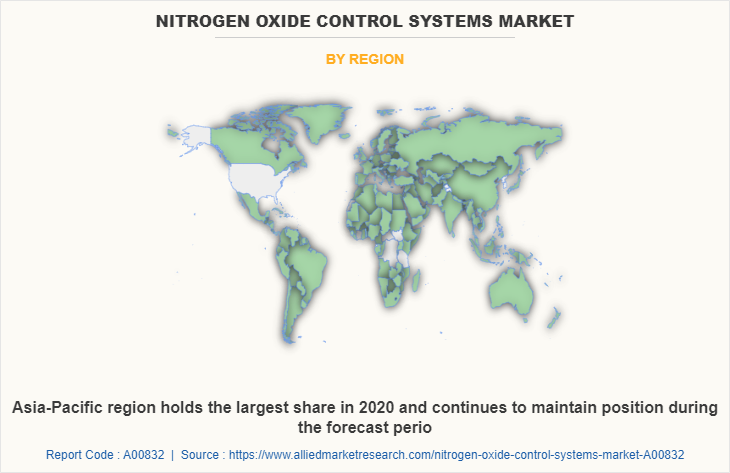Nitrogen Oxide Control Systems Market Research, 2030
The global nitrogen oxide control systems market size was valued at $4.3 billion in 2020, and is projected to reach $7.3 billion by 2030, growing at a CAGR of 5.4% from 2021 to 2030.
Nitrogen Oxides are a family of poisonous and highly reactive gases. These gases form when fuel is burned at high temperatures. NOx pollution is emitted by automobiles, trucks, and various non-road vehicles (e.g., construction equipment & boats) as well as industrial sources such as power plants, industrial boilers, cement kilns, and turbines. NOx often appears as a brownish gas. It is a strong oxidizing agent and plays a major role in the atmospheric reactions with volatile organic compounds (VOC) that produce ozone (smog) on hot summer days. As nitrogen oxide is quite harmful to all living being, it is required to be controlled. There are various methods to control nitrogen oxide. Some of the methods are fuel switching, fuel pre-treatment, combustion (or chemical process) modification and flue (or tail) gas denitrification. In addition, various key players offer nitrogen oxide control system, which continuously monitors feedback from the NOx sensor(s) and regulates the system response by proportionally adjusting liquid and air flow to the injector nozzles.
Some control system of nitrogen oxide are combustion control, choice of fuel, process modification, Reburning, low NOx burners, flue gas recirculation (FGR), staged combustion (off-stoichiometric combustion), reduced air preheat & reduced firing rates, water or steam injection, low-excess-air firing (LEA), flue gas treatment, selective catalytic reduction (SCR), and selective non-catalytic reduction (SNCR).

Segment Overview
The nitrogen oxide control systems industry is segmented on the basis of technology and application. By technology, it is classified as Selective Catalytic Reduction (SCR), Selective Non-Catalytic Reduction (SNCR), Low NOx Burner, Fuel Reburning, and Others. By application, it is categorized as transportation, industrial application, power generation & energy chemical, and others. By region, the market is analyzed across North America, Europe, Asia-Pacific, and LAMEA.
Global Market, By Technology
By technology, Selective Catalytic Reduction (SCR) segment dominated the global nitrogen oxide control systems market share in 2020, and is projected to remain the fastest-growing segment during the forecast period. This is attributed due to its fuel mixing characteristic. In addition, Low NOx burners are designed to control air and fuel mixing at each burner, which creates more branched and larger flames. By reducing the peak flame temperature, significantly less NOx is formed in the process.

Global Market, By Application
By Application, the transportation segment dominated the global nitrogen oxide control systems market in 2020, and is projected to remain the fastest-growing segment during the forecast period as emissions can be reduced by making process changes (such as modifications to the combustion process) or by installing air pollution control equipment (such as selective non-catalytic reduction (SNCR) or selective catalytic reduction (SCR)).

Global Market, By Region
By region, Asia-Pacific dominated the nitrogen oxide control systems market size in 2020, and is projected to remain the fastest-growing segment during the nitrogen oxide control systems marketforecast period. This is attributed to numerous factors such as large population and industries in the region.
Import and export activities were significantly impacted, which, in turn, adversely affected the industries using nitrogen oxide control systems and thereby affected the nitrogen oxide control systems market.

Competitive Analysis
The key players profiled in this report include Babcock & Wilcox Enterprises, Inc., CECO Environmental, Ducon Technologies Inc., Fuel Tech, Honeywell International Inc., John Wood Group plc, Mitsubishi Hitachi Power Systems, Ltd., S.A. HAMON, Siemens AG and The Shell Group
Key Benefits for Stakeholders
- This report provides a quantitative analysis of the market segments, current trends, estimations, and dynamics of the nitrogen oxide control systems market analysis from 2020 to 2030 to identify the prevailing nitrogen oxide control systems market opportunities.
- The market research is offered along with information related to key drivers, restraints, and opportunities.
- Porter's five forces analysis highlights the potency of buyers and suppliers to enable stakeholders make profit-oriented business decisions and strengthen their supplier-buyer network.
- In-depth analysis of the nitrogen oxide control systems market segmentation assists to determine the prevailing market opportunities.
- Major countries in each region are mapped according to their revenue contribution to the global market.
- Market player positioning facilitates benchmarking and provides a clear understanding of the present position of the market players.
- The report includes the analysis of the regional as well as global nitrogen oxide control systems market growth, key players, market segments, application areas, and market growth strategies.
Nitrogen Oxide Control Systems Market Report Highlights
| Aspects | Details |
| By Technology |
|
| By Application |
|
| By Region |
|
| Key Market Players | Fuel Tech, The Shell Group, Babcock & Wilcox Enterprises, Inc., Siemens AG, Honeywell International Inc., Ducon Technologies Inc., CECO Environmental, John Wood Group plc,, Mitsubishi Hitachi Power Systems, Ltd, S.A. HAMON |
Analyst Review
Various CXOs from leading companies perceive nitrogen oxide control system market as an area of potential growth owing to the improvements in nitrogen oxide control system technologies that have enabled industrial and transportation frameworks to consider nitrogen oxide control system as a feasible and economic option. In addition, elevated levels of nitrogen dioxide can cause damage to the human respiratory tract and increase a person's vulnerability to, and the severity of, respiratory infections and asthma. Long-term exposure to high levels of nitrogen dioxide can cause chronic lung disease. However, with all such effect, governments of several nations imposed regulations to control nitrogen oxide that encourage the nitrogen control system market, which lead to surge in number of key players in the market.
Asia-Pacific will provide more business opportunities for global nitrogen oxide control systems in future
Low NOx Burner segment holds the maximum share of the Nitrogen Oxide Control Systems Market.
Agreement, business expansion and product launch are the key growth strategy of nitrogen oxide control systems market players.
Babcock & Wilcox Enterprises, Inc., CECO Environmental, Ducon Technologies Inc., Fuel Tech, Honeywell International Inc., John Wood Group plc, Mitsubishi Hitachi Power Systems, Ltd., S.A. HAMON, Siemens AG and The Shell Group are the leading market players active in the nitrogen oxide control systems market.
Rising environmental concern and emission control regulation and rising automation may act as the major driving factor for the market. In addition, rapid increase in technological advancement may create lucrative opportunities for the market.
Loading Table Of Content...



